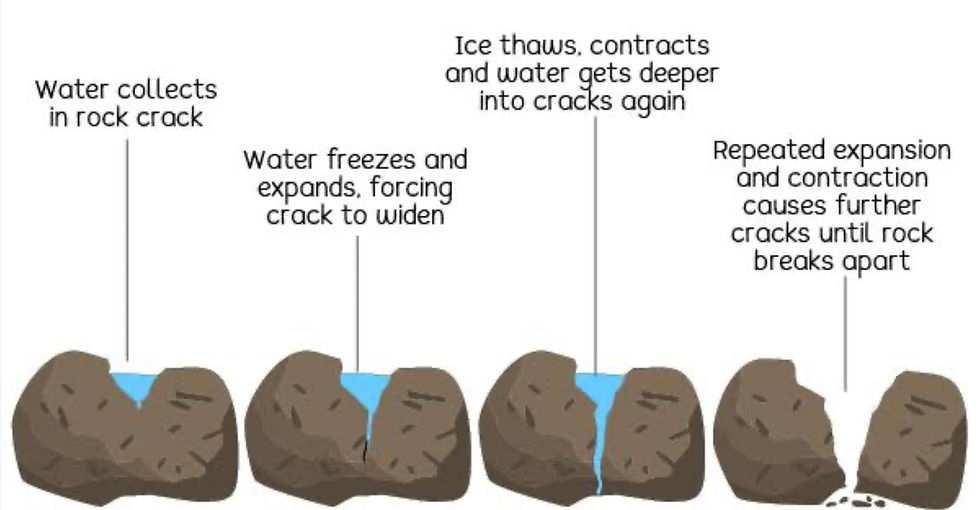Page number 114 and 115.
Weathering is the natural process of rocks, soils, and minerals breaking down or dissolving at or near the Earth's surface. This process is driven by various agents like water, ice, wind, temperature changes, and living organisms. Weathering is distinct from erosion, which involves the movement of weathered materials.
Types of Weathering:
Physical Weathering:
This involves the mechanical breakdown of rocks without changing their chemical composition. Examples include:
Freeze-Thaw: Water seeps into cracks in rocks, freezes, expands, and cracks the rock.
Temperature Changes: Rocks expand and contract due to temperature fluctuations, causing stress and cracks.
Wind and Water Abrasion: Wind and water carry sand and other particles that erode rocks.
Chemical Weathering:
This involves changes in the chemical composition of rocks, making them weaker and more susceptible to breakdown. Examples include:
Dissolution: Water dissolves certain minerals in rocks.
Oxidation: Oxygen reacts with certain minerals, causing them to weaken and crumble.
Hydrolysis: Water reacts with minerals to form new compounds, altering their structure.
Biological Weathering:
This involves the weathering action of living organisms. Examples include:
Plant Roots: Roots grow into cracks in rocks, widening them and breaking the rock apart.
Burrowing Animals: Animals can disrupt the soil and rocks, increasing their vulnerability to weathering.
Significance of Weathering:
Soil Formation:
Weathering is a crucial step in soil formation, as it breaks down rocks into smaller particles that mix with organic matter.
Landform Creation:
Weathering and erosion work together to shape the Earth's landscape, creating mountains, valleys, canyons, and other landforms.
Rock Cycle:
Weathering is an important part of the rock cycle, contributing to the formation of sedimentary rocks.








![HOW TO ANALAYSE A PERSON, TO IF HE IS GOOD OR BAD. [MY EXPIRENCE]](https://static.wixstatic.com/media/338b83_3327cd5272eb4e17a1de3b1cab48e7a3~mv2.png/v1/fill/w_443,h_250,fp_0.50_0.50,q_35,blur_30,enc_avif,quality_auto/338b83_3327cd5272eb4e17a1de3b1cab48e7a3~mv2.webp)
![HOW TO ANALAYSE A PERSON, TO IF HE IS GOOD OR BAD. [MY EXPIRENCE]](https://static.wixstatic.com/media/338b83_3327cd5272eb4e17a1de3b1cab48e7a3~mv2.png/v1/fill/w_78,h_44,fp_0.50_0.50,q_95,enc_avif,quality_auto/338b83_3327cd5272eb4e17a1de3b1cab48e7a3~mv2.webp)


What role do living organisms play in the weathering process?
How does acid rain accelerate chemical weathering, and what are its long-term effects?
Can weathering ever be beneficial to ecosystems?
How does freeze-thaw weathering affect structures like roads and buildings?
What are some famous natural landmarks formed primarily by weathering?
How does weathering interact with erosion to shape the Earth's surface?